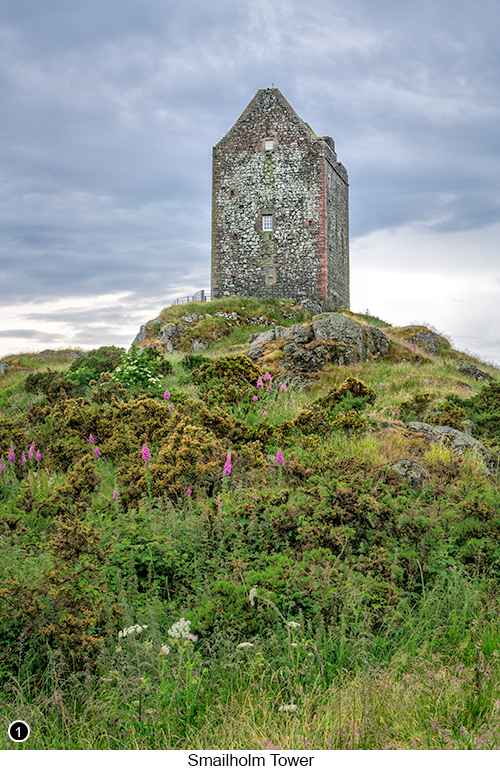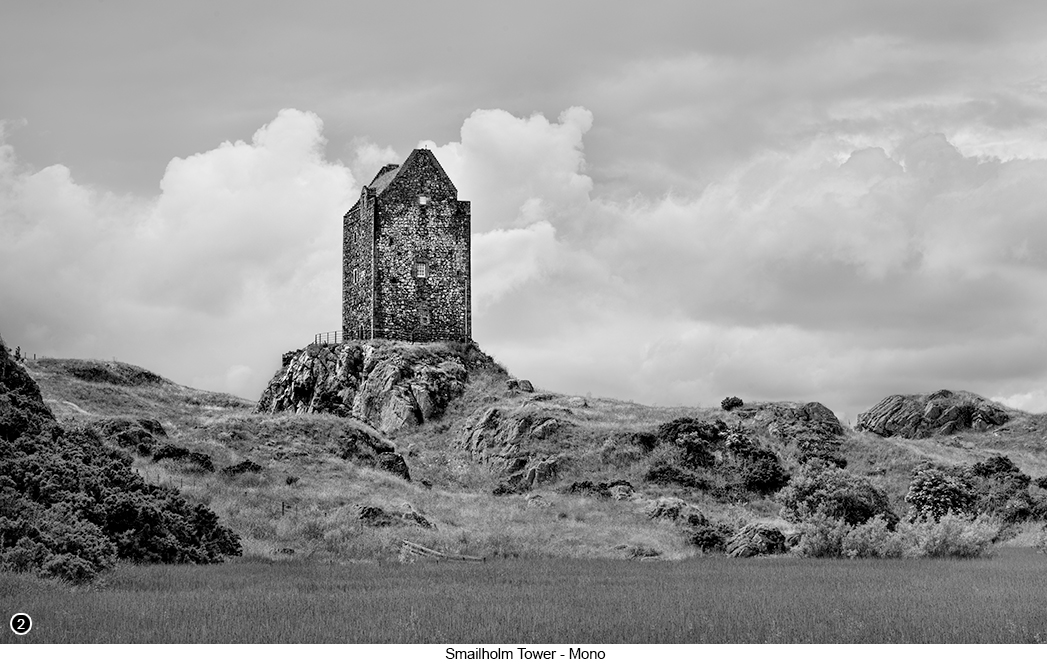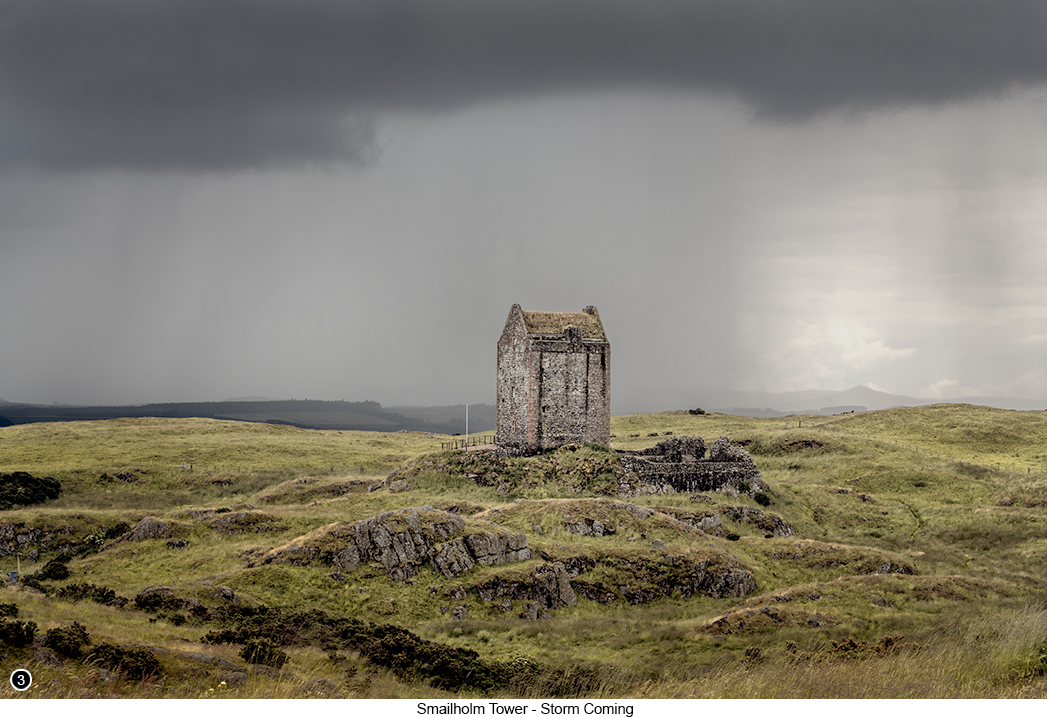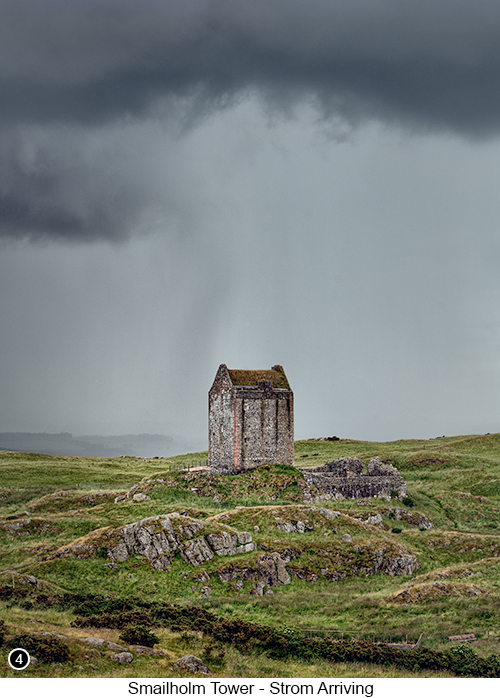

Smailholm Tower |
Smailholm Tower was built on the 'Crag of Lady Hill' in the mid 1400's, in a style that is now commonly referred to by historians as a "Peel Tower" or "Tower House", which is basically a large multi floored vertically flat walled house and stronghold, which can be thought of as being very similar to a single corner turret of a castle. Buildings like this became widely adopted by the ruling classes, across the entire length of the border between Scotland and England, as trade and wealth began to expand between the two kingdoms. But the reason the landowners were forced to begin building fortified homes in this way, was initially due to them being relentlessly attacked by large gangs of lowland marauders and cattle thieves from both sides of the hotly disputed border, who then became more widely known as the infamous and much feared "Border Reivers". |
|
 |
Setting the scene: The Border Reivers were a large, but loosely organised disparate clan of opportunist thieves and plunderers from both sides of the border, who for many generations had a totally free reign, across a wide stretch of land between the two kingdoms, as they continued to plunder and pillage whatever they pleased and from whoever they pleased. Then from around the start of the 1500's onwards, this area also started being attacked by squads of free roaming English soldiers, who were originally sent up to the borders to quell the increasingly brazen attacks by the Reivers and to implement law and order across the region. But which then quickly degenerated into yet more mayhem and violence, as the English army (Redcoats) continued to extend its control further North beyond the border and take whatever it could find along the way. This meant that the owners of fortified tower houses like Smailholm, were now under constant threat of unprovoked and quite often murderous attacks, coming in from all sides without notice. Be it from other local Scottish Clans trying to expand their control over the borderland area, as well as to increase their cut of the wealth and trade now being generated between the two kingdoms, to large gangs of marauding thieves and bloodthirsty Border Reivers, through to a newly mobilised and well equipped foreign army, who regarded themselves as not only being the law, but above it. So if you were lucky enough to be born into a wealthy Scottish land owning family between the 15th and 16th centuries, yet at the same time be unluckily enough to be living anywhere along the Scottish/English Border, then your home truly did have to become your castle, or you weren't going to be living there for much longer, or probably anywhere else for that matter. For more information about Smailholm Tower, how it was designed and constructed and some of the more notable families and people who have lived there over the generations, click this link for a larger full screen view of the information board, that you will find in the car park next to the tower. Sir Walter Scott's was also a regular visitor to the Smailholm Tower as a child and which he later wrote about in his poem "Marmion":
|
How to get there - From the city of Newcastle, drive North along the A696 heading towards the village of Elishaw Map View, then continue driving straight on passed Elishaw, as the A696 then becomes the A68 and continues to head North towards the village of Jedburgh Street View, Map View. Now look for the sign that points you towards St Boswells and the 'Visitor Attractions' that can be found further along the B6404 and take this road Street View, Map View. Then continue driving on for several more miles, until you see a left turn signposted for the Smailholm tower and turn left here Street View, Map View. You should now be driving up a narrow, single width track, that starts to rise slowly, as it climbs up a low hill and where you will soon come to a farm house, that has several large outbuildings situated on both sides of the road, surrounding a working farmyard area and that you then have to drive through to get up to the tower. And yes you are definitely allowed to drive through this working farmyard by the way and at any time of day, although I must admit it can feel more than a little bit uncomfortable if the farm staff are working in the yard, as you then try to negotiate your way around lots of large agricultural machinery, as well as a long line of agitated cows waiting to be milked and who have absolutely no intention of moving out of your way. So it can definitely feel, as if we shouldn't be allowed to drive through the centre of this farm whenever we like, but as I said just a moment ago, you are allowed, as this is the only way to get to the tower. When we were driving towards Smailholm Tower and about 50 miles away, the sun was shining brightly and it was sticky hot, but with towering, white, cumulus clouds, gathering menacingly on the far horizon and straight in the direction we were headed. I thought to myself mmm, they look very interesting, but could we get there before the light disappeared under those clouds, as they were obviously the precursor to a major storm that now seemed to be brewing all around us. Then as we drew closer and about 20 miles from the tower, we started to drive through areas of localised flooding and deep pools of water laying across the road and my excitement began to mount. On we drove, with one minute being bathed in harsh bright sunshine and where the scenery all around us looked completely bone dry, to then drop down a hill into a tiny village the next minute, where everything was steaming wet and dripping with water and the central street looked more like a fast flowing river. I began to think to myself "bloody typical", we are going to get there just in time to see the clouds move in and everything go black, so that we can hardly see a thing and then to top it off, we are probably going to get stuck on top of the Lady Hill Crag, surrounded by a localised flooding event! Anyway, I tried to push these negative thoughts out of my mind, as we drove on towards the fast approaching towers of cloud and where I began to put my foot down even harder, which made my poor, long suffering wife, start to moan to me about such things as "do we need to drive so fast?" and "can't we slow down and just enjoy the scenery?" etc., as she hung on tightly to the door handles and began leaning into the bends, until we finally got into the Smailholm Tower car park and where I threw on my 70/200 zoom and leapt out of the car, to start shooting the scene as if my life depended on it. |
|
 |
|
Having now parked your vehicle in the large official car park, you will see the tower directly in front of you, but with the bottom part of it obscured by a low rocky hill that sits in front of it. So to get a clear view of the tower without it being semi obscured by the hill, I walked back as fast as I could down the road I had just driven in on for about 50 yards, until I could fully see the tower on top of the crag more clearly and is where I then took the image shown at the top of the page in SHOT 1. I actually took SHOT 1 shown at the top of the page shortly after the storm had passed, but as this will probably be the first view of the tower you will shoot, due to it being the closest to the car park, so I am showing you that image first. I then continued walking at speed away from the car park and back the way I came in and then onto the other end of a small, but often reflective lochan - it is worth mentioning here, that this small lochan had completely grown over with reeds and grasses during this my most recent visit (see SHOT 2 above ) , but which was still open water when I came here only a couple of years ago in winter. So these grasses may actually die back during the winter months, to once again open up to what is a great view across quite a reasonably sized body of water in front of the tower, which on a calm day will give you the opportunity to shoot it with a reflection - and we all like a good reflection don't we? Or perhaps the farmer has drained this small lochan for some reason, or nature has taken its course over the years and filled it in with sufficient silt, to allow it to become completely overgrown with reeds and grasses, who knows? So if you try typing "Smailholm Tower" into your search engine right now, most of the images that pop up will indeed show you this tower with a reflective body of water in front of it, but don't expect it to be here any more, or at least not if you visit this location, at any other time than in the depths of winter, when this lochan might just temporarily open up once again. I then walked briskly back to my vehicle and the official car parking area, where I continued to scout for more photo opportunities, as the ominously dark clouds began to merge together and move towards me and which I knew, meant I wouldn't have much longer before the downpour would begin. So even though I did not have much time to wander around the outside of the tower, I still wanted to try and shoot the tower from a different angle and produce something, that I hoped would be different from all the other images of this tower you might find on the internet. But time and the elements were against me, so instead of going up to the tower and scouting around the base of it, I instead looked to see if I could get a little higher and then shoot the tower from a different perspective. I then walked past the car park on my left and further along the track heading away from the tower and then on through a large pair of open metal cattle gates, as I looked to see if there was a way I could easily get up to the top of the bracken and gorse covered rocky outcrop, that rises up behind the car park on the opposite side of the track to the tower - these large metal gates are usually left open by the farmer, when there are no cows or bulls grazing on this part of his land and so you are able to explore further up this track, but if these gates are closed, then the farmer has done so for a reason and so you will just have to stick to shooting from the area around the tower itself. I then saw an old wooden gate with a small thumb latch to open it on my right, in front of a short track that seemed to be leading up to a fenced off area at the top of the crag, so I went through the old wooden gate (making sure that I securely locked it again afterwards of course) and headed off up the track. Then once at the top of the track, I came to a fenced off area, around what looked like a small water treatment station, but where I could see a gap up the right side of the fence and the rocks. So I hurried up through this gap and which quickly led me up to a rocky outcrop area on top of the crag and a fairly unique view of the tower and the land that surrounds it, as shown below in SHOT 3. |
|
 |
|
The wind was now starting to blow wildly, as the temperature plummeted and the first stinging drops of rain began to hit me in the face. I could see what I thought was the edge of the storm moving swiftly across the scene in front of me (as shown above), but with the sky behind it starting to light up with shimmering sheets of lightning, followed quickly by heavy rumbling thunder, that was ripping across the scene in front of me from left to right. Now we all like a bit of drama in our landscape photographs don't we, but this was becoming a little too scary, a little too quickly, as I now found myself standing on the top of, one of the two highest points in about a 25 mile radius, under what was quickly turning into a high energy electrical storm, that was barrelling relentlessly towards me. And there I stood, getting wet and with a camera mounted onto a large tripod and acting like I was some sort of a human lightening conductor in a Frankenstein movie. Exhilarating? Yes absolutely. The smartest thing to be doing during a thunder storm? Probably not. |
|
So after telling myself to stop being such a complete idiot and trying to get myself killed and after staying up there for only a few minutes and a couple of shots, I wrapped everything up as quickly as I could and scurried back down to the safety of the car, just in time for a wall of water and pebble sized pieces of hail to sweep across us. You see when the storm did finally reach us and hit us full on, the wind started howling and bouncing the car around on its springs and it felt more like we were disappearing under a waterfall, than it did a curtain of rain. In fact you can see how quickly the weather was deteriorating in SHOT 4 on the right. when compared to SHOT 3 above, which are two shots separated by only a couple of minutes. We then sat there for around 2 hours, until we finally saw a break in the storm coming towards us from the horizon on the left and so I decided to splash my way out of the car park and wander around the tower one more time, just to see if I could grab a few extra handheld shots, before we headed off back home. The best of which is shown at the top of the page in SHOT 1. Honesty in image editing! In a couple of these shots, you may notice there is a large shiny metal flagpole next to the tower, but that in the other two shots I have taken the pole out. And that is simply because for two of the shots, I found the pole to be nothing but a distraction, so I cloned it out and in the other two shots, I found it wasn't so much of a distraction at all, so I left it in. Now I know that some of you photographers out there of a more purist persuasion, will be shaking your head at my willingness to do this and thinking we photographers, should always leave such things alone and that tidying up the shot afterwards with the clone tool, is somehow against the rules of accurate depiction or something. Well OK I suppose you are correct and I would have to agree with you, but only if I was shooting this scene for commercial reasons, such as a tourist information brochure etc and where it needs to be shown as it actually is. But I wasn't, I was taking these shots for my own pleasure and to create, what I hoped to be my vision of the scene and so I didn't mind doing this, especially when I am then willing to tell everyone what I have done and why. So if you go to this location and you think that the flagpole should remain visible in every one of your shots, then go for it I say and do whatever it is that fulfils your vision and that you enjoy doing. But if you are like me and you don't mind a little bit of post process tidying to take place, because you think the shot will be improved by doing so, then again my advice would be to go for it and do whatever it is that makes you happy. I mean we all see the world differently don't we and we all have our own limits of what we find acceptable and unacceptable. Which for me are things like replacing the sky, or rearranging the trees, or moving a mountain around in the background and any other thing that fundamentally changes the layout of the shot, so that it then becomes more about my skills at post processing, than it is about my vision as a landscape photographer, who is only trying to show you what you will find when you are here. This isn't a rant by the way, as I do really believe we should all be allowed to work within our own flexible boundaries of enjoyment and never try to limit the enjoyment of others, by insisting they adhere to our own arbitrary rules and restrictions. |
 |
| . | |
--Exif information for each of the numbered shots shown throughout this chapter --1 - Canon EF70-200/2.8L IS USM, 1/160th Sec, f/11, ISO 320, Focal Length 73mm, taken on 4th Jul at 16:55 --3 - Canon EF70-200/2.8L IS USM, 1/50th Sec, f/16, ISO 200, Focal Length 70mm, taken on 4th Jul at 15:05 --4 - Canon EF70-200/2.8L IS USM, 1/200th Sec, f/8, ISO 200, Focal Length 90mm, taken on 4th Oct at 15:07 |
|
If you have enjoyed reading these 'Extra' chapters to my Guide Book and think you might also enjoy reading 79 more chapters across 270 pages, that also includes more than 340 Fine Art quality images, along with detailed descriptions and large scale maps to guide you to the exact location of where I took each and every one of them and which then goes onto discuss the techniques and tools I used to process them, but where everything is written in plain easy to understand English? Then please consider buying the Book. |
|